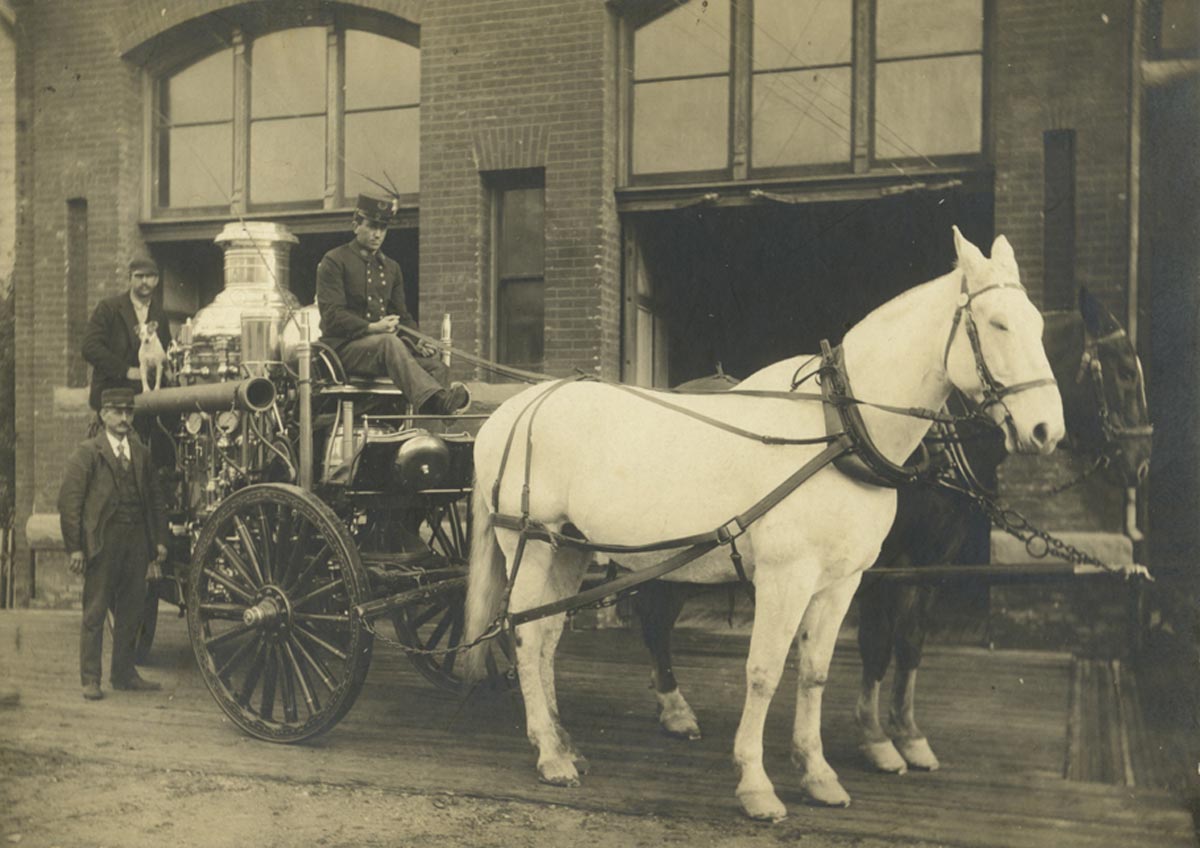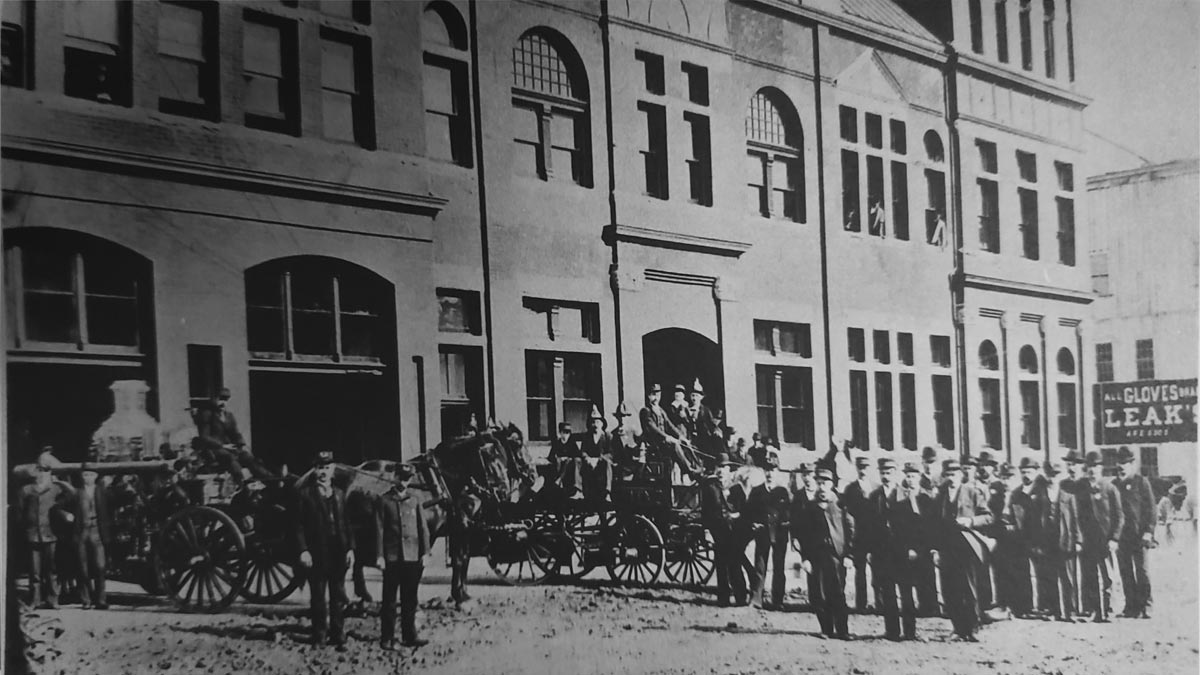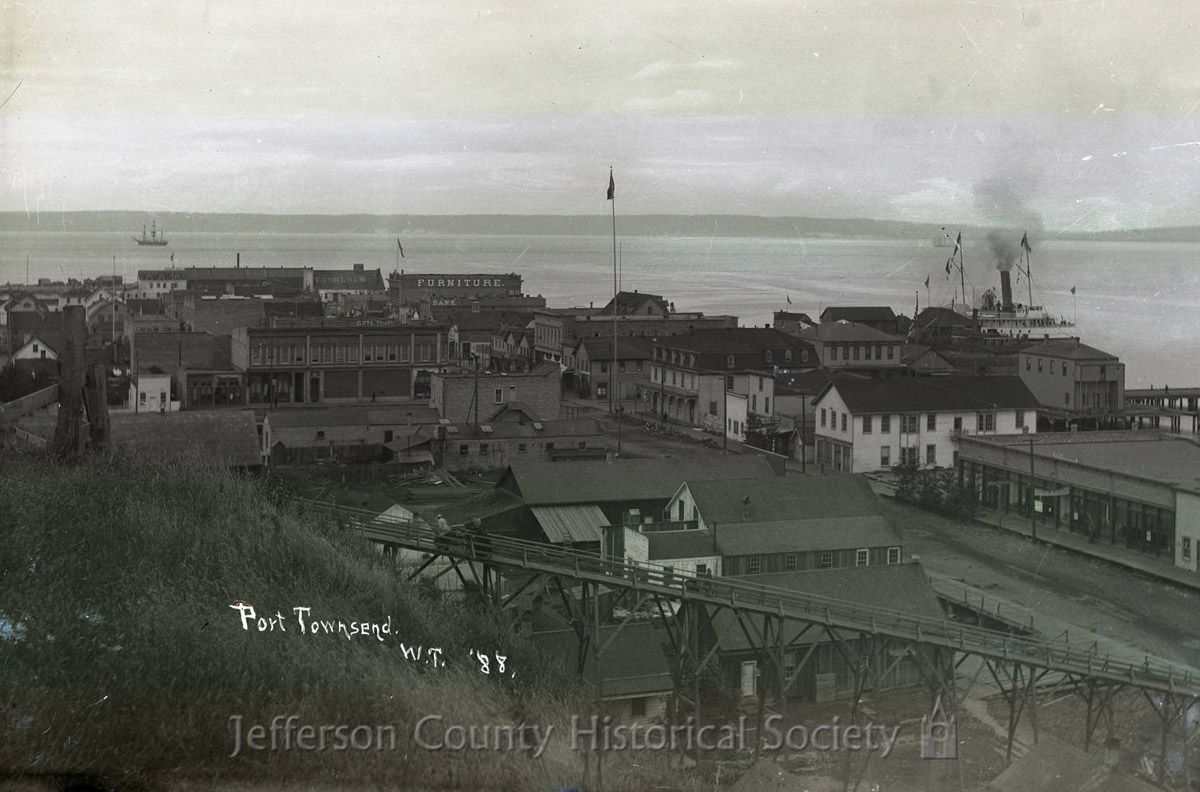FIRE!
Learn how fire has changed Port Townsend through the years.
Like most early cities, Port Townsend suffered from fires that could damage or destroy homes and businesses.
Tightly packed buildings heated with wood fires and lite by kerosene lamps were always at risk. When disaster struck, entire city blocks could be lost in a few hours.

The earliest buildings in Port Townsend were constructed entirely of wood, but as the town prospered in the 1880s they were often replaced with “fire proof” brick structures. Fire continued to be a threat however, in the fall of 1885 a fire began at a blacksmith shop in the block between Taylor and Tyler streets, destroying around 20 buildings. In 1900 Port Townsend was hit by two major fires, one Uptown and one Downtown. The first fire happened in June that year, leveling the area that is today the commercial section of Uptown. The second fire consumed multiple blocks between Quincy and Madison Streets, including the area that is now Memorial Field. At the time of the fire, the section of town was primarily Chinese-American businesses and residences. Buildings closer to the waterfront were saved by water pumped from the tug boat Tatoosh at the Quincy Wharf.
The last really large, multiple structure fire was in April of 1923. This fire destroyed the Learned Opera House, and damaged both the Bishop Building and the Yee Sing, Wo Kee Co. building to the West. the Bishop Building is said to have only survived due to the metal shutters over its windows. With hours of work, the fire department was able to save the Yee Sing, Wo Kee building as well.

Port Townsend Fire Department ca 1890
Notable Fires in Port Townsend History
August 23, 1871 – the S’Klallam village of qatay was burned by order of the federal government.
Sept 6, 1885 – Downtown fire at 2:30 am Moffetts & Co blacksmith in the Water, Washington, Taylor, and Tyler block spread rapidly burning every building in the block except Chet Terry’s Livery Stable, consuming 20 buildings in total including the Hastings Estate buildings, Weymouth & Bills Blacksmith, C.M. Bradshaw building & office and many smaller losses.
Aug 21, 1886 – The Port Townsend Call in 1886 reports a fire, started by nearby forest fires, burned the school house at Leland to ashes. Students of teacher Kate Morgan lost all their books and school’s furniture.
June 17, 1900, the fire leveled blocks bounded by Lawrence, Clay, Tyler and Polk streets. From June 17, 1900 Sunday Leader: Fire discovered by N.W. O’Rear (of the Leader) who tried to sound the alarm but the key had been hidden in Aldrich’s grocery and was only known by a few people. Instead he had to run down to the Fire Tower so that they could send for the hose, wagon, and engine – resulting in a long wait for the first water to be laid on the blaze. The fire destroyed a prosperous block of Uptown businesses and residences including: Miss Willoughby’s art studio, a dressmaking shop, Anders’s ice cream parlors, Mrs. Pringle’s millinery, David Patterson’s shoe store, Aldrich’s, Jones Cyclery, Jacob Bros’ general store, Shattuck’s billiard parlor, and Mrs. Webb’s millinery store. The fire was so hot it ruined every plate glass window on the opposite side of the street and set fire to woodwork in McLennans and the displays in Stuart Bros furniture store before being extinguished by bucket brigades. Almost no one was insured because the cost of insurance on wood frame buildings was so high. The next city council meeting saw action taken to put alarm keys in boxes with glass doors and the purchase of an additional 1000 ft of hose.
Sept 24, 1900, Downtown fire destroyed multiple blocks from Jefferson to Quincy. Destroyed buildings included two and three-story frame structures erected during the late 1880s and early 90s and the house of ill fame in which the fire started. Great cinders were carried blocks away to start fires near the Quincy Street wharf. These were extinguished by the tug Tatoosh moored at the dock who attached a hose to her pumps and sent several strong streams of salt water onto burning buildings and imperiled structures nearby. The fire was ostensibly caused by “one of the city’s ‘soiled doves’ during a moment of carelessness inspired by intoxication.” Mona Hervey was found unconscious at the scene but recovered and fled before medical treatment arrived. An article states she was “merely drunk and partially suffocated.” Michael DeLeo’s saloon was burnt, but the contents saved by the ready assistance of the patrons. Buildings west of DeLeo’s on Washington street were Chinese stores and lodging houses. Grounded electrical wires blacked out the city and it remained in darkness until 2am.
March 22 1903 A nighttime blaze destroyed little property but claimed a number of lives. Exactly at midnight last night an alarm was sounded and peopled rushing out found the entire lower end of the city illuminated to an extent that indicated serious conflagration. From uptown it appeared that the fire was in Downs sawmill on lower Water St, but close approach developed the conflagration to be among the huts on the beach occupied by the siwashes. Just how the blaze started is a mystery but it is rumored that the conflagration was attended by a terrific loss of life, everyone that could not crawl away was burned in the embers of their homes. (Leader)
July 8, 1914 – Another fire broke out in a house of prostitution and threatened the downtown business area on July 8, 1914. Originating in the “Green Light” behind city hall, just 6ft from the old fire department quarters. This fire marked the end of the Green Light.
Apr 6, 1923 – W.H. Learned’s Opera House, burned early morning Apr 6, 1923. Suspected work of pyromaniac who ignited other major structures that same year (Eisenbeis Hotel, June 23). Firemen brought the fire under control about 3am after more than an hour. Wooden structures including those occupied by the Yee Sing, Wo Kee Co. west of the burning building, and Bishop Building east of it were spared by firemen who saved the Yee Sing, Wo Kee building. Bishop survived b/c of 16 metal window shutters.

Port Townsend Fire Department ca 1892

The Harrison Street hill climb (here pictured in 1888) linked the downtown and uptown districts.
It’s steep grade made transporting fire fighting equipment uphill difficult. JCHS 1989.42.2
Learn More of Our History
